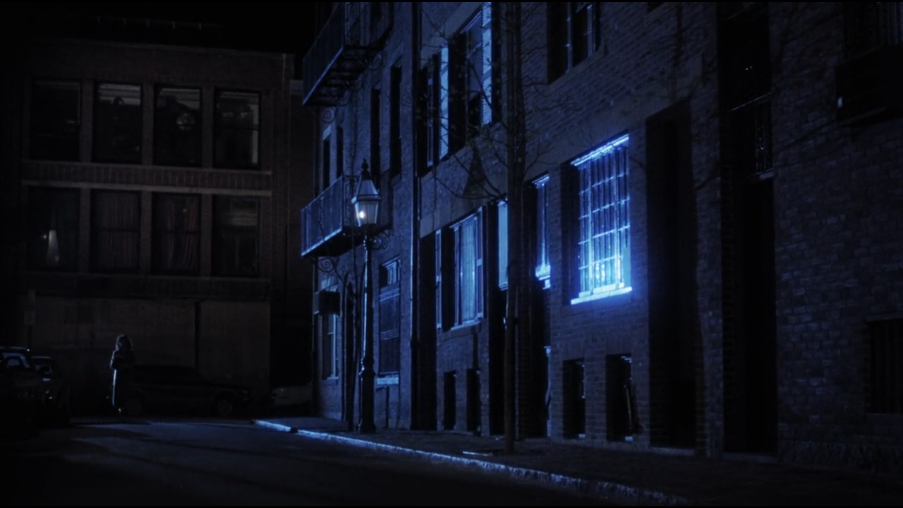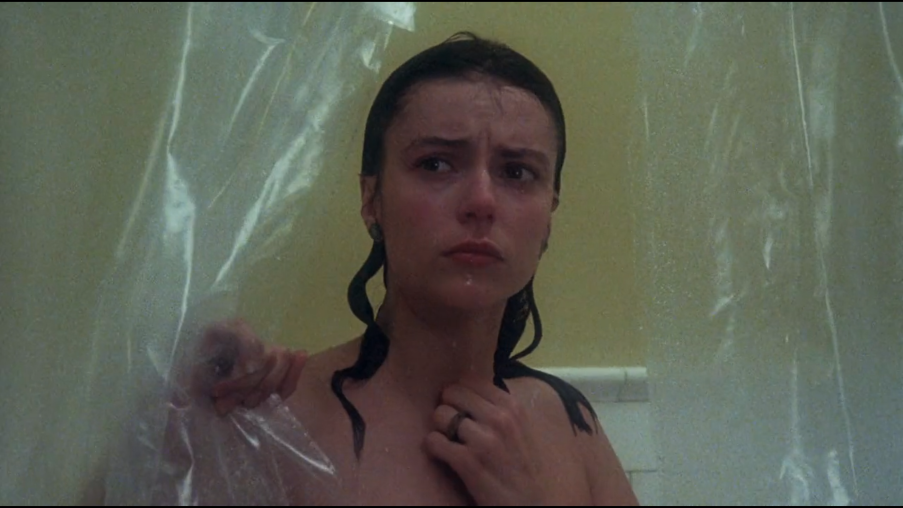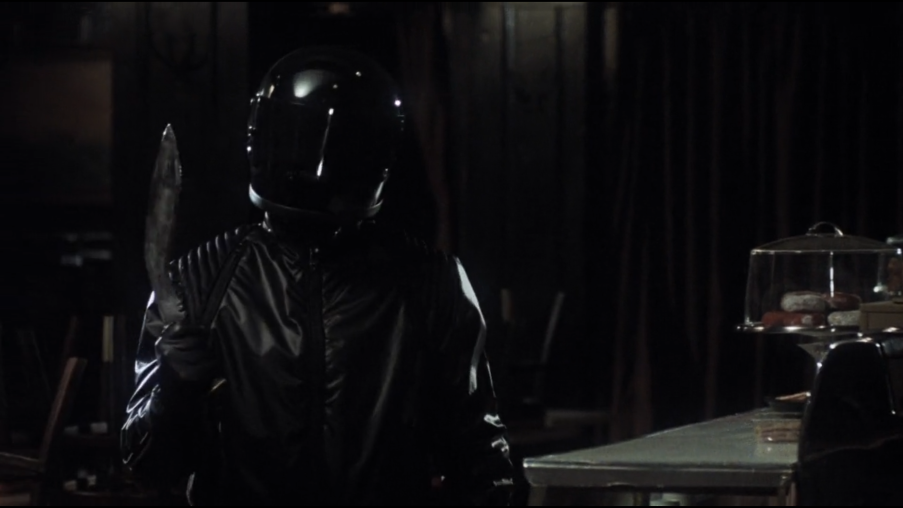NIGHT SCHOOL
Directed by Ken Hughes. 1981. United States.

NIGHT SCHOOL definitely benefits from the general incompetence and laziness of the subgenre it belongs to. It is a slasher film that doesn't quite fit with the rest of its early 1980s brethren. It feels different, much more like a giallo film than yet another routine stalk and slash parade. It has a particularly grimy look to it without a hint of the kind of pop aesthetic that usually accompanies a slasher film made during the most aggressively garish of decades.
The film feels lived in, slimy and dirty. None of the actors (even the gorgeous Rachel Ward) look particularly actorly, if that's the right way to put it. It might sound hyperbolic, but compared to other films of the era, it looks downright cinema verite.
It's that particular level of visual reality, the look attained by shooting the flick in the less than touristy parts of Boston, that helps make NIGHT SCHOOL, at the very least, a kind of one-off in the slasher sub-genre. It has the look of a police thriller and the attitude of one to boot, and those two elements help the tacky veneer of the 1980s slasher film to feel absent, even though the script plays out according to slasher rules. It is very obviously inspired visually by the giallo film, right down to the motorcycle gear worn by its killer which appears to be lifted from either STRIP NUDE FOR YOUR KILLER or WHAT HAVE THEY DONE TO YOUR DAUGHTERS?. While the narrative differences between the middle-to-late era giallo film and the average slasher are few, one of the things that have always kept the two at a great distance was the presentation and NIGHT SCHOOL manages to nail it solidly. In fact, if you swapped the low rent side of Boston setting for the back alleys of Rome, you wouldn't have to change a single thing about it in order for it to play well within the giallo.
The story is simple and to the point. We begin with the murder of a teacher's aide named Ann in the playground of a school. The police find her body close to where the attack took place. The head however is on the other side of the lot, sitting in a bucket of water. This is the second attack this week and both murders are strikingly similar. Both victims were decapitated, their severed heads found submerged in water (the first disembodied head was found in a duck pond). The cops investigating the crimes, Lieutenant Judd Austin and his partner Sergeant Taj, quickly zero in on the only link the two girls have in common. They both attended Wendall College, an all-girls school in the city. Judd meets with Helene Griffin, the headmistress of the school, and an anthropology professor named Vincent Millett, neither of whom are very much help. One of Ann's friends, Kim, gives Judd his first lead. Ann was seeing a much older man.

It doesn't take Judd long to put two and two together. He confronts Millet about his involvement with Ann, but Millet denies knowing anything about her death. He also meets Millet's obsessive girlfriend, a British research assistant/exchange student named Eleanor. Eleanor has had her suspicions that Millet was fooling around with other students, even though Millet denied it repeatedly. While having coffee at a local diner, she meets a flirty, mouthy waitress named Carol who is all too happy to fill her in on the gossip regarding Millet's womanizing ways. Eleanor leaves the diner but finds herself being followed by Gary, a slow-witted, creepy guy who works as a busboy at the diner. Soon enough, more bodies are being found decapitated, their disembodied heads submerged in water.
The most disappointing thing about NIGHT SCHOOL is how uncomplicated the narrative is, especially with its foot so firmly in the giallo (in fact, I'm sure several of you can guess the killer's identity right now). It becomes rather apparent halfway through the film as to who the killer is. So apparent that it causes the viewer a good bit of frustration. How the hell do the cops not see it? Well, they don't see it because they don't have the same vantage point we do obviously (and if they did, there wouldn't be a movie), but the fact that the solution to the mystery is so clear as day does cheapen the experience a bit. Some gialli did the mystery elements better than others and the best examples were always those films that allowed us to uncover the killer's identity with the detectives, amateur or otherwise. They felt interactive and immersive. Here, we spend much of the running time just waiting for the other shoe to drop as the solution to the case is so readily apparent. For the first time ever I wished there were more red herrings in a film.
That isn't to say the film slacks off completely. When NIGHT SCHOOL decides it wants to be suspenseful, it pulls it off admirably. There are a couple of extremely well-done sequences in the film and it becomes more and more obvious as it goes on that director Ken Hughes (whose only other notable films were the decidedly ungiallo-like OF HUMAN BONDAGE, a few bits of CASINO ROYALE, and the family classic CHITTY CHITTY BANG BANG) and writer/producer Ruth Avergon were not only well-versed in horror and thriller conventions but with the techniques of the master of suspense himself, Alfred Hitchcock. There are clever misdirections too, such as the killer slowly emerging from behind a door instead of their usual bursting into frame, numerous gliding shots which only sometimes indicate the killer's point of view and - especially - the incredibly amusing turnaround when we fully expect someone to find a severed head in a pot of beef stew. There are several winks to classic suspense films, like PSYCHO, THE BIRD WITH THE CRYSTAL PLUMAGE and HALLOWEEN, and they're all pulled off so well that I never once considered turning NIGHT SCHOOL off and turning one of those films on. It's a low budget, low intellect flick that delivers so many good moments that it is a shame when it doesn't quite come together.

That's no more evidenced than during the films numerous murder set pieces, all of which involve a soon-to-be victim slowly backing away while the killer repeatedly slashes them to death. It's during these sequences that NIGHT SCHOOL feels quite bored with itself, like the murders are just necessary evils the film has to show for the sake of ticket sales. What it wants to be is a mystery, not a bloodbath, and when the screams come and the stage blood starts pouring, the film nosedives into more standard, complacent territory. Hughes was clearly trying to make a film that transcended the usual drive-in fare, even going so far as to work in a little self referential humor every now and then.
That isn't to say that NIGHT SCHOOL ever truly devolves into comedy. The in-jokes are relatively few and the film maintains an aura of deadly seriousness from start to finish. But it knows what it is and isn't afraid to acknowledge it from time to time. Even by 1981 the slasher film was beginning to cycle back on itself, so we're treated to a character moaning about the tired, old "head in the fishtank" routine and the by-now standard trick ending is turned on its head and laughed at. Hughes and Avergon are well aware of what they expect us to find around every corner and for every time they deliver, they subvert our expectations and provide us with a little something new (well, new at the time anyway; it's all old hat now). But they never let the playfulness trump the dedication to telling their story straight (had this film been released only a few years later, the image of a hockey mask sitting on the shelf surrounded by pictures of nude women would have been a real crowd-pleaser). They strike that balance well, hitting far more than they miss, and it really does keep NIGHT SCHOOL on track and elevate it to just slightly below the top tier of slasher films.